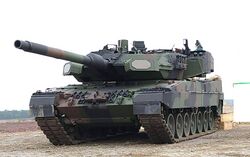M1725 MBT: Difference between revisions
mNo edit summary |
No edit summary |
||
| Line 51: | Line 51: | ||
==Production== | ==Production== | ||
The AE-145 engines would be put into production at Maycross’ Zareda Engine Plant, and transported by rail to NMI’s factory in Noursala. Here, the engine and powertrain systems would be fit into the chassis. | The AE-145 engines would be put into production at Maycross’ Zareda Engine Plant, and transported by rail to NMI’s factory in Noursala. Here, the engine and powertrain systems would be fit into the chassis. | ||
The first three M1725s were produced as field-test models to test the vehicles handling and weapons systems. After given the greenlight by the OoA, full-scale production began with a line of ten produced. | |||
[[Category:Weaponry]] | [[Category:Weaponry]] | ||
Revision as of 13:26, 22 September 2023
 A M1725 at an army testing range | |
| Type | Main Battle Tank |
|---|---|
| Place of Origin |
|
| Designed | 1720 AN-1723 AN |
| Production | 1724 AN- |
| # Built |
|
| Dimensions |
|
| Produced by |
|
| Armament |
|
The M1725 MBT (informally known as the Albatross) is an Aerlan main battle tank in service with the Grand Army of Aerla. It was developed in the early 1720 ANs by the Noursala Military-Industrial Company and Maycross Engineworks. Research began when members of the Armed Forces High Command (Overkommand-ovð-Armë) petitioned for the creation of a modern armored tank capable of supporting infantry companies.
Development History
Background
In 1720 AN, the Chief of the Armored Corps of the Grand Army, noted Junker aristocrat General-ovð-Armör Freidrich Hæften von Motte, voiced concern with the poor quality of tanks previously deployed in army operations. For example, many of the armored vehicles who took part in the Bloch-Dobbs Expedition had poor quality motors that constantly required maintenance and often got stuck in even light mud. Large portions of this armor was simply left behind in Port Aerla.
Von Motte reached out and contracted both Noursala Military-Industrial and Maycross Engineworks to research and develop a new, more reliable tank for the GAR. After much negotiation and financial planning, development soon began. It was decided that NMI would develop the armor and weapons system, while Maycross would develop the engine and powertrain system.
Development
Development for the engine proved to be the first major roadblock of the project. No motor previously even conceptualized by Maycross could drive a main battle tank. After many trials using several prototypes, a final build model, the MEW AE-145, was decided to be put into production. The AE-145, a 1450 Horsepower liquid-cooled engine that ran at 2500 RPM, was the first of its type produced in Aerla.
NMI also hit several roadblocks in the way of armor. After much debate and planning, it was decided to use a composite material of steel, tungsten, and specialized (and also classified) filling. The major roadblock in this regard was the tungsten, as Aerla has 5 tungsten mines throughout the whole nation. NMI settled on essentially buying out the tungsten supply of the Greymark Mine located in the northeast of the country.
NMI decided on using a 40 round, 120mm caliber gun as the main armament for the tank. There would also be a 7.62 mm chain gun, as well as a 7.52x51 mmHokmashinerëfle hatch machine gun.
Production
The AE-145 engines would be put into production at Maycross’ Zareda Engine Plant, and transported by rail to NMI’s factory in Noursala. Here, the engine and powertrain systems would be fit into the chassis.
The first three M1725s were produced as field-test models to test the vehicles handling and weapons systems. After given the greenlight by the OoA, full-scale production began with a line of ten produced.